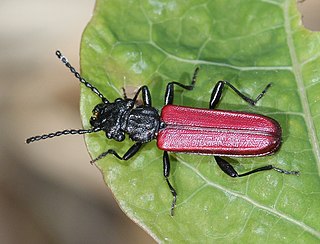
The Cucujidae, "flat bark beetles," are a family of distinctively flat beetles found worldwide under the bark of dead trees. The family has received considerable taxonomic attention in recent years and now consists of 59 species distributed in four genera.

Colydiinae is a subfamily of beetles, commonly known as cylindrical bark beetles. They have been treated historically as a family Colydiidae, but have been moved into the Zopheridae, where they constitute the bulk of the diversity of the newly expanded family, with about 140 genera worldwide. They are diverse for example in the Australian region, from where about 35 genera are known; in Europe, though, only 20 genera are found and many of these only with few species.
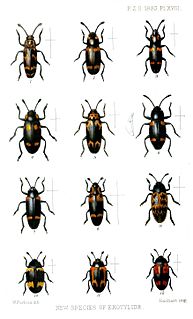
Erotylidae, or the pleasing fungus beetles, is a family of beetles containing over 100 genera. In the present circumscription, it includes the subfamilies Dacninae, Encaustinae, Erotylinae, Megalodacninae, and Tritominae. In other words, the narrowly circumscribed Erotylidae correspond to the subfamily Erotylinae in the definition sensu lato. They feed on plant and fungal matter; some are important pollinators, while a few have gained notoriety as pests of some significance. Sometimes, useful and harmful species are found in one genus, e.g. Pharaxonotha. Most pleasing fungus beetles, however, are inoffensive animals of little significance to humans.

Cucujus is a genus of beetles in the family Cucujidae, the flat bark beetles. It contains 19 currently recognized species and subspecies.

Jacobsoniidae is a family of beetles. The larvae and adults live under bark, in plant litter, fungi, bat guano and rotten wood. It is a small family with 23 described species in three genera:

Laemophloeidae, "lined flat bark beetles," is a family in the superfamily Cucujoidea characterized by predominantly dorso-ventrally compressed bodies, head and pronotal discs bordered by ridges or grooves, and inverted male genitalia. Size range of adults is 1–5 mm (0.04–0.2 in) in length. Currently, it contains 40 genera and about 450 species, and is represented on all continents except Antarctica; species richness is greatest in the tropics.

Silvanidae, "silvan flat bark beetles", is a family of beetles in the superfamily Cucujoidea, consisting of 58 described genera and about 500 described species. The family is represented on all continents except Antarctica, and is most diverse at both the generic and species levels in the Old World tropics.
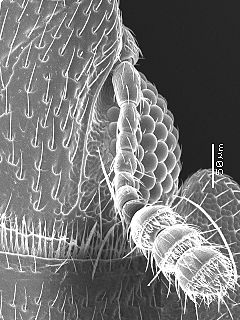
Carinophloeus is a genus of beetles in the family Laemophloeidae consisting of only two obscure, uncommonly collected species. Carinophloeus is one of only two laemophloeid genera having the middle coxal cavities closed by the meso- and metasternum. The species are small, flattened brownish beetles with abundant pubescence composed of thick, reclinate setae, and carinate pronotum and elytra. The type species of the genus, Carinophloeus raffrayi, is the only laemophloeid currently known with antennal grooves; C. zairensis has antennae of only 10 antennomeres.
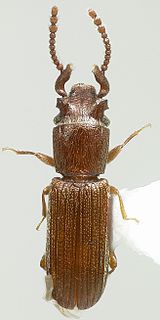
Dysmerus is a genus of beetles in the family Laemophloeidae. Restricted to the New World, until recently Dysmerus included only the type species, D. basalis, described from Florida in the late 19th century. A recent revision resurrected two incorrectly synonymized species and recognized an additional 12 new species, so that the genus currently contains 15 species.

Laemophloeus is a genus of beetles; it is the type genus of the family Laemophloeidae. The genus has been almost completely reviewed in modern times. Following by recognizing only those species congeneric with the type species, Laemophloeus monilis (Fabricius), as valid members of the genus reduces the size of the genus from more than a hundred species to only 28, as follows :
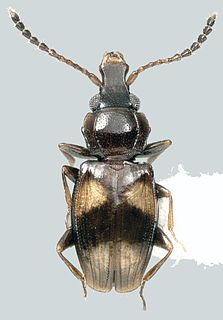
Metaxyphloeus is a genus of beetles in the family Laemophloeidae. It belongs to a small group of rostrate laemophloeid genera endemic to the New World. Members of Metaxyphloeus range from southern Texas south to Bolivia. Related rostrate genera are Rhinomalus and Rhinophloeus. Adults are moderate-sized laemophloeids (~2 mm) characterized by their prolonged heads, open procoxal cavities, an acuminate intercoxal process on the first visible abdominal ventrite, antennal club of six antennomeres, and male genitalia lacking a dorsal piece of the tegmen. Metaxyphloeus adults are dark brown or black, shining, with or without dorsal pubescence, and with one or two pairs of pale elytral maculae. Their biology and immature stages are unknown. Adults may be attracted to light in forest habitats. The function of the rostrum is unknown.
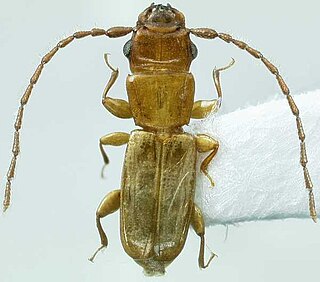
Placonotus is a genus of beetles in the family Laemophloeidae. There are 40 currently recognized species, known from all continents except Antarctica. Placonotus species are small (~2mm), elongate, flattened beetles, characterized by long filiform antennae, presence of a frontoclypeal suture, open anterior coxal cavities, and broadly rounded intercoxal process of abdominal ventrite III. Males have the 8th abdominal segment modified to form claspers used during mating. Adults and larvae are found under dead bark, where they feed on fungi. Currently recognized species are:

Rhinolaemus is a genus of beetles in the family Laemophloeidae. Until recently, the genus included only Rhinolaemus maculatus, known from a single specimen collected almost 100 years ago in Fiji. A recent revision, based on newer collections, resulted in the description of a new species from Niue Island, and transferral of a third species from Laemophloeus from Fiji and other island groups.

Palaestes is a genus of beetles in the family Cucujidae. It contains eight currently recognized species. Like all members of the Cucujidae, adults are greatly dorso-ventrally compressed. All known species of Palaestes are brightly colored red or yellow and black, and the males have curiously modified mandibles that look like ice tongs; female mandibles are not modified. Palaestes shares with the Australian-New Zealand genus Platisus the character of the male genitalia, which lacks a flagellum, lying on its side in the abdomen, versus inverted in Cucujus and Pediacus.

Philothermus is a genus of minute bark beetles in the family Cerylonidae. There are about 17 described species in Philothermus.
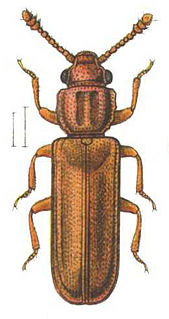
Pediacus depressus is a species of flat bark beetle in the family Cucujidae. It is found in Europe & Northern Asia.
Pediacus ommatodon is a species of flat bark beetle in the family Cucujidae. It is found in North America.

Pediacus subglaber is a species of flat bark beetle in the family Cucujidae. It is found in North America.
Pediacus stephani is a species of flat bark beetle in the family Cucujidae. It is found in North America.
Pediacus andrewsi is a species of flat bark beetle in the family Cucujidae. It is found in North America.















